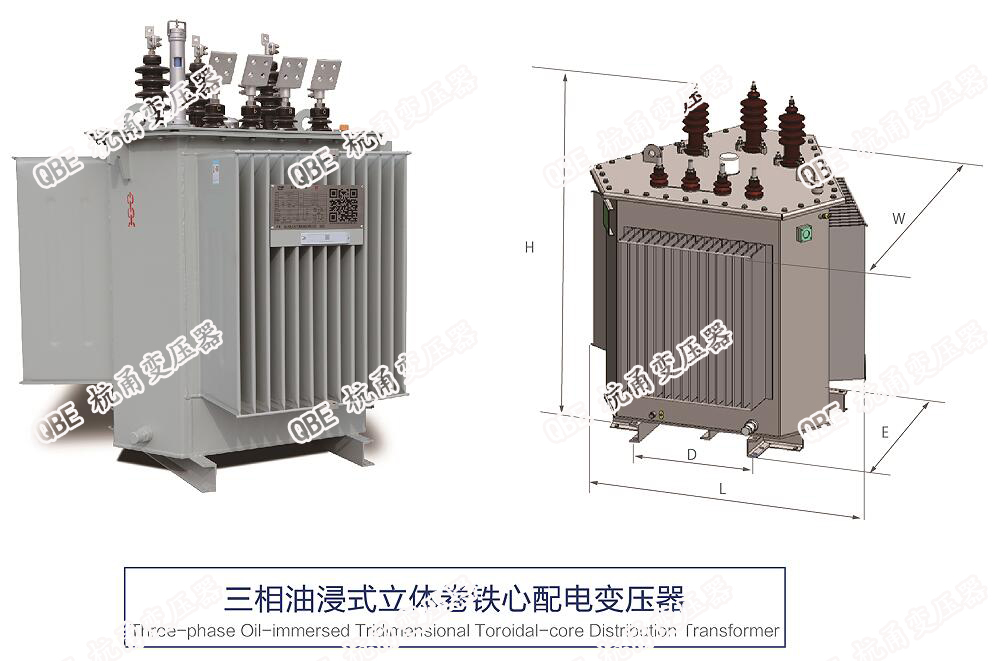
Driven by the national energy conservation and emission reduction policies, energy-saving transformers are becoming more and more widely used and are being promoted as a prairie fire. In order to reduce the loss and noise of the transformer operation itself, we can achieve energy-saving in product operation, save materials in the manufacturing process, and optimize the technical cost performance, so as to meet the higher requirements for energy-saving, environmental protection, and low noise put forward by rapid economic development for transformers. The development direction of wound core transformers has gone through the development process from single-phase, three-phase plane to three-phase three-dimensional, and is a process of continuous technological innovation.
Compared with the S11 transformer of the same capacity, the no-load loss of the three-dimensional wound iron core is reduced by more than 25%, the no-load current is reduced by more than 70%, and the noise is reduced by 7~10dB(A). Compared with the S13 laminated structure transformer with the same capacity, the amount of silicon steel sheet used is saved by more than 20%, the amount of copper used is 2 - 3%, the no-load current is reduced by more than 50%, and the noise is reduced by 4 - 6 dB (A).
At the same time, the no-load current is small, which can reduce network losses; secondly, improve network power factor; thirdly, improve the effective utilization rate of power supply network equipment; and fourthly, reduce the investment in reactive power compensation equipment, which can greatly save equipment investment and operating costs.
If S13-type three-dimensional wound core transformers are used in distribution transformers across the country, about 100,000 tons of silicon steel sheets and about 10,000 tons of copper materials can be saved a year. The energy saving amount of product operation is converted into 1.45 million tons of standard coal, which is quite impressive.
At present, three-dimensional wound core products benefit from their distinctive technical characteristics: they are produced from traditional silicon steel materials, and three core single frames form a three-dimensional equilateral triangular structure. The three magnetic circuits have the same length and are all the shortest; three-phase balanced, low no-load loss and low noise; under the same conditions, silicon steel is saved by about 20% and copper is saved by about 3% during the manufacturing process; it is a dual energy-saving and high-reliability transformer for manufacturing and operating.
Driven by the national energy conservation and emission reduction policies, energy-saving transformers are becoming more and more widely used and are being promoted as a prairie fire. In order to reduce the loss and noise of the transformer operation itself, we can achieve energy-saving in product operation, save materials in the manufacturing process, and optimize the technical cost performance, so as to meet the higher requirements for energy-saving, environmental protection, and low noise put forward by rapid economic development for transformers. The development direction of wound core transformers has gone through the development process from single-phase, three-phase plane to three-phase three-dimensional, and is a process of continuous technological innovation.
Compared with the S11 transformer of the same capacity, the no-load loss of the three-dimensional wound iron core is reduced by more than 25%, the no-load current is reduced by more than 70%, and the noise is reduced by 7~10dB(A). Compared with the S13 laminated structure transformer with the same capacity, the amount of silicon steel sheet used is saved by more than 20%, the amount of copper used is 2 - 3%, the no-load current is reduced by more than 50%, and the noise is reduced by 4 - 6 dB (A).
At the same time, the no-load current is small, which can reduce network losses; secondly, improve network power factor; thirdly, improve the effective utilization rate of power supply network equipment; and fourthly, reduce the investment in reactive power compensation equipment, which can greatly save equipment investment and operating costs.
If S13-type three-dimensional wound core transformers are used in distribution transformers across the country, about 100,000 tons of silicon steel sheets and about 10,000 tons of copper materials can be saved a year. The energy saving amount of product operation is converted into 1.45 million tons of standard coal, which is quite impressive.
At present, three-dimensional wound core products benefit from their distinctive technical characteristics: they are produced from traditional silicon steel materials, and three core single frames form a three-dimensional equilateral triangular structure. The three magnetic circuits have the same length and are all the shortest; three-phase balanced, low no-load loss and low noise; under the same conditions, silicon steel is saved by about 20% and copper is saved by about 3% during the manufacturing process; it is a dual energy-saving and high-reliability transformer for manufacturing and operating.